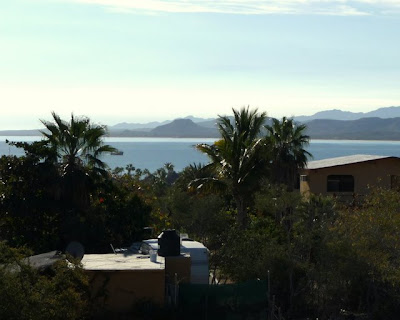There are quite a few things, some minor, some major, which are different about home life in Mexico. Now that we’ve spent 6 weeks in a Mexican house, rather than in our RV, we’ve learned a few things we thought we’d share.
While this is probably not true in mountain regions, houses here in the lowlands don’t have heat. No furnace, no base-board heaters, no wall heaters. It’s just not needed. Or at least that’s mostly true. We had 3 days a couple weeks ago that were cloudy and cool, and we found the house a little too chilly for our comfort in the mornings, so we brought our tiny space heater in from the RV and ran it for about half an hour. Houses here also don’t have smoke alarms. Again, they’re just not needed. The house we’re in, like most houses in the vicinity, is built entirely of concrete – walls, floors, ceilings, kitchen and bathroom counters, all are made of concrete. Only the doors and windows aren’t concrete, and they’re not wood either. So nothing in our Mexican house could burn except for bedding and clothing. So no smoke alarms.
Like all deserts, water is at a premium here in Baja. One of the ways municipal water systems manage supply is by rationing water somewhat. Here in Los Barriles, the water is turned off to half the City for about 6-8 hours every other day. The other half of the City has its’ water turned off on alternate days. This has posed no problems for us. The way it’s handled is that every house is built with something called a “tanaka” or a “pila”. A tanaka is a black plastic water tank – somewhere between 200 – 500 gallon size – installed on the roof during construction of the house. It remains full at all times by virtue of a pump that automatically re-fills it as water is used. So on days when the City water is off, residents draw their water, powered by gravity, from the tanaka so they can shower, flush toilets and wash dishes. A “pila” is essentially the same thing, but is installed underground and is much larger in capacity. The pila for our house holds 3,000 gallons, and again, has a pump that keeps it automatically re-filled whenever we take a shower, run the laundry, or whatever. We have yet to notice the days on which the water is turned off except in one respect: outside faucets can’t be connected to the tanaka or pila, so people can’t wash their car or water their yard or wet down the roadway in front of their house (to keep the dust down) on those days.

Though we’re told summers here are extremely hot -- long periods where the temp passes 100 degrees every day -- most houses owned by Mexicans are not air-conditioned, and most houses owned by gringos only have air-conditioning units mounted in the bedrooms so they can sleep comfortably. Whenever possible, people have trees near the house to keep it shaded and cool, and the concrete structure holds the cool night air better than homes built of other materials. Ceiling fans are very common. Our next-door neighbor and friend Russett, who has lived here year-round for the past 2 years, tells us that July and August are made up of “three-shower days” – shower when you get up in the morning, shower before lunch, and shower before dinner. And even then, you sweat all day. I think we’ll stick to coming here in the winter!
















![124-070316200-1210229314[1] 124-070316200-1210229314[1]](https://blogger.googleusercontent.com/img/b/R29vZ2xl/AVvXsEj2pGMfpGTFMXRJpR-x2lgwaHIT6jotE1S2PaoI65WGKsNa2pAF6eCIjBHhQo495F8hHFg1_HyldTh9h5tuWaKdSbJFTCVCd5LaurUV0EpYB-SUet1Fcks0Y7NTffUY9Fs0O_XQ2Fz_Ayk/?imgmax=800)
































